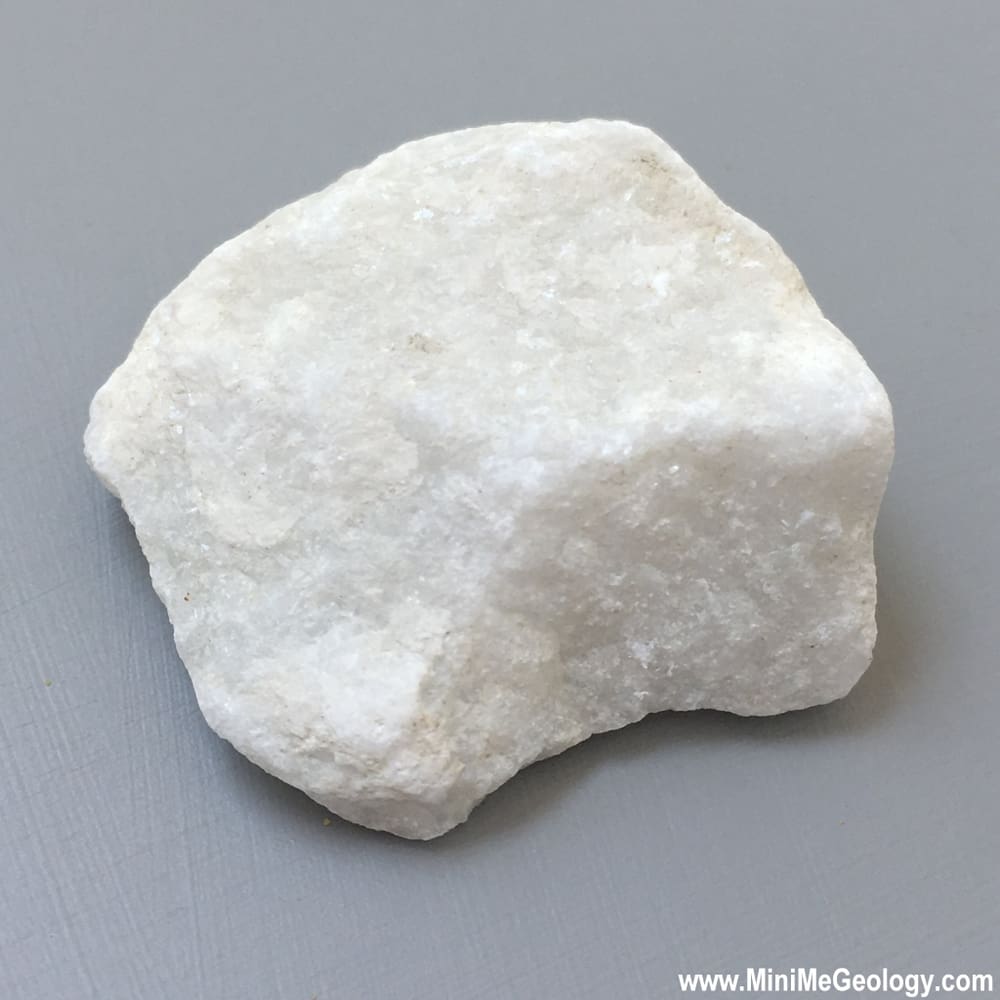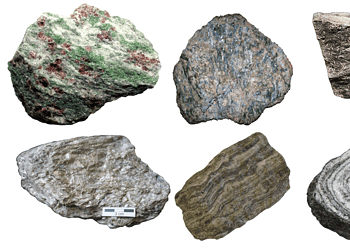
Marble is one of the most beautiful types of rock on Earth. From the majestic Taj Mahal to Michelangelo’s iconic sculptures, marble’s legacy is undeniably etched in the annals of history and human culture. But did you know marble’s geology is no less awe-inspiring? Let’s dive right into the science of marble.
What is Marble?
Marble is a metamorphic rock formed from the transformation of limestone or dolomite under extreme heat and pressure. This process, known as metamorphism, alters the original carbonate mineral grains of the protolith (original rock), leading to the recrystallization of calcite or dolomite.
The unique crystalline structure and interlocking mosaic of carbonate crystals give marble its distinctive appearance, setting it apart from its sedimentary precursor. But there’s more to marble than that.
Formation and Composition of Marble
Marble forms through a process known as metamorphism, where limestone or dolomite sedimentary rocks are subjected to major heat and pressure. As the temperature and pressure increase, the original carbonate mineral grains in the limestone or dolomite begin to recrystallize.
- Temperature: Marble generally forms at temperatures ranging from about 500 to 800 degrees Celsius (930 to 1470 degrees Fahrenheit). These temperatures are typically achieved at depths of 15 to 30 kilometers (9 to 19 miles) in the Earth’s crust.
- Pressure: Alongside temperature, significant pressure is required for the formation of marble. This pressure usually ranges from 1.5 to 2.5 gigapascals. The pressure helps in recrystallizing the rock, altering its texture and composition.
This transformation typically occurs under two main geological settings:
- Convergent Plate Boundaries: Large areas of Earth’s crust at these boundaries are subjected to intense heat and pressure, leading to regional metamorphism.
- Contact Metamorphism: This occurs when a hot magma body heats adjacent limestone or dolostone. This type of metamorphism is also common at convergent plate boundaries but can happen wherever there is an intrusion of magma.
As the metamorphic process progresses, calcite crystals undergo recrystallization, growing larger and interlocking with one another. This recrystallization phase is crucial as it not only increases the crystal size but also obscures the original fossils and sedimentary structures within the limestone.
The level of metamorphism is directly correlated with the size of the calcite crystals in marble. Lower levels of metamorphism result in smaller crystals, while higher levels lead to larger, more prominent crystals. As the metamorphic level increases, clay minerals within the rock may also transform, evolving into micas and more complex silicate structures. In some instances, this can even lead to the formation of precious gem minerals such as corundum, which includes rubies and sapphires.
The composition of marble is predominantly that of calcite or dolomite, but its final appearance – particularly its color and veining – is significantly influenced by other minerals and impurities present in the original rock.
For instance, pure marble, free of impurities, is typically white. However, the presence of impurities like iron oxides can impart hues of pink, red, or yellow, while traces of graphite or other organic materials can lead to gray or black marbles.
Characteristics of Marble
Marble’s allure and widespread use in architecture, sculpture, and design stem from its distinct characteristics. These traits not only define its physical appearance but also determine its suitability for various applications.
Hardness and Durability:
Marble’s relative hardness is a significant factor in its application. While softer than granite, it is sufficiently hard to withstand a considerable amount of wear and tear. This medium hardness also makes it more amenable to carving and shaping, a quality highly prized by sculptors throughout history. Its durability ensures longevity, particularly in interior settings, making it a favored material for buildings and monuments.
Texture:
Marble is known for its smooth texture and crystalline structure that can range from fine to coarse, depending on the size of the crystals formed during the metamorphic process. This smoothness is not just tactile but also translates to a visual softness, making marble surfaces highly desirable for their aesthetic appeal.
Color Variability:
Pure marble is typically white, but it can come in a range of colors. This variability is due to the presence of various impurities such as iron, graphite, or organic residues in the original limestone or dolomite. These impurities can impart a wide spectrum of colors to marble, from pinks and reds to greens and blacks, adding to its decorative versatility.
Veining:
One of the most distinctive features of marble is its veining, which results from the presence of mineral impurities. These veins are formed during the metamorphic process when impurities are mobilized and recrystallized within the stone. The patterns created are unique to each marble slab, making every piece one-of-a-kind.
Light Transmission:
An often-overlooked characteristic of marble, especially varieties like white Carrara, is its translucency. Some thinner slabs of marble can transmit light, giving them a slightly glowing appearance when backlit. This quality has been utilized in various architectural applications to create stunning visual effects.
Acid Sensitivity:
Marble is composed mainly of calcium carbonate, which reacts with acidic substances. This reaction can lead to etching or dulling of the marble’s surface, a consideration important in its maintenance and use, especially in areas prone to exposure to acidic substances like kitchen countertops.
Heat Resistance:
Marble has good heat resistance properties, which makes it a popular choice for fireplace surrounds and hearthstones. However, its heat resistance is not as high as granite’s, so care should be taken with very hot items.
Porosity:
Despite its solidity, marble is a porous material. This porosity means it can absorb liquids, leading to staining if not properly sealed. This characteristic is particularly relevant for marble used in kitchens and bathrooms.
How to Identify Marble
To identify marble, look for:
- Cool Temperature: Marble remains cool to the touch.
- Veining Patterns: Unique, often intricate vein designs are a hallmark.
- Acid Reaction: Marble effervesces in contact with dilute hydrochloric acid due to its calcium carbonate content.
- Hardness Test: It can be scratched with a metal blade, distinguishing it from harder stones like granite.
Types of Marble

Marble comes in a myriad of types, each distinguished by its color, veining, and place of origin. However, because marble is used for industrial purposes (and aesthetic purposes), the classification of marble is not purely geological, but also considers practical characteristics. Some notable examples include:
Carrara Marble
Originating from the Carrara region in Tuscany, Italy, this marble is famed for its use in Roman and Renaissance art. It’s characterized by its soft white or blue-gray background and subtle, feathery veining. This type of marble has been used in some of the world’s most famous sculptures, including Michelangelo’s David.
Calacatta Marble
Also hailing from Italy, Calacatta marble is a luxurious variety known for its bright white background contrasted with dramatic, bold veining. Each slab of Calacatta marble is unique, making it a sought-after material for statement pieces in architecture and interior design.
Crema Marfil
Crema Marfil is a textured, creamy beige marble from Spain. Its uniform color and subtle veining make it a popular choice for large areas, such as flooring, where a warm, consistent appearance is desired.
Emperador Marble
This Spanish marble is notable for its range of brown tones, from light to deep chocolate, accented with strong, contrasting veins. Emperador marble is often used in combination with lighter-colored marbles and is popular in both flooring and decorative applications.
Verde Antico
Known for its striking green color, Verde Antico is a serpentine-rich marble. This type of marble, with its deep green hues interspersed with white or light green veins, is often used for ornamental or decorative pieces.
Pietra Grey
Originating from Iran, Pietra Grey marble is characterized by its dark grey or almost black background, laced with striking white veins. It offers a dramatic and contemporary look, making it popular for modern interior designs.
Makrana Marble
Famous for being used in the Taj Mahal, Makrana marble comes from the Makrana region in India. It’s known for its high purity and lack of color variation, ranging from pure white to off-white.
Yule Marble
Sourced from Colorado, USA, Yule marble is known for its uniform texture and bright white color, with minimal veining. It’s famously used in the Lincoln Memorial in Washington, D.C.
Tennessee Marble
Tennessee marble, primarily sourced from East Tennessee, is a dense, fossiliferous limestone that is often mistaken for marble. It’s known for its pink, rose, and salmon shades and is used both in historical and contemporary architecture.
Uses of Marble
Marble’s versatility is evident in its wide range of applications:
Architecture and Building

Marble has been a favored material in architecture for centuries, evident in historical landmarks like the Parthenon in Greece and the Taj Mahal in India. Its durability, resistance to erosion, and aesthetic appeal make it suitable for both interior and exterior applications. Marble is used in flooring, wall cladding, columns, staircases, and facades. It adds a touch of elegance and luxury to any space it adorns.
Sculpture
Since classical times, artists have preferred marble for its softness and resistance to shattering, making it ideal for carving. The translucency of marble, particularly white varieties like Carrara, gives sculptures a lifelike quality. Famous sculptures like Michelangelo’s David and Pieta showcase the timeless beauty of marble in art.
Furniture and Decor
Marble is also popular in furniture and home decor. It is used in tabletops, kitchen countertops, bathroom vanities, and decorative items. Its natural patterns and colors bring a unique and sophisticated look to home interiors.
Tiles and Mosaics
Marble tiles are a classic choice for bathrooms and kitchens, offering both beauty and durability. Mosaic tiles made of marble add a decorative element to floors, walls, and even ceilings, providing an artistic touch to interior spaces.
Landscaping and Outdoor Features
In landscaping, marble is used for garden pathways, benches, fountains, and statues. Its resistance to weathering makes it suitable for outdoor use, where it ages gracefully, adding character to gardens and outdoor spaces.
Industrial Uses
Beyond its aesthetic applications, marble is used in various industrial processes. Crushed marble is a key ingredient in the production of calcium carbonate, a filler and coating pigment in paper, plastics, and paint. Fine marble dust is also used in agriculture as a soil treatment agent.
Conclusions
Marble is often prized for its elegance and durability in both natural and crafted forms. Its unique formation process, variety, and characteristics make it an endlessly fascinating subject for geologists and artisans alike. Whether in the form of a majestic structure or a delicate sculpture, marble continues to captivate and inspire, standing as a testament to the timeless beauty of Earth’s geological processes.



